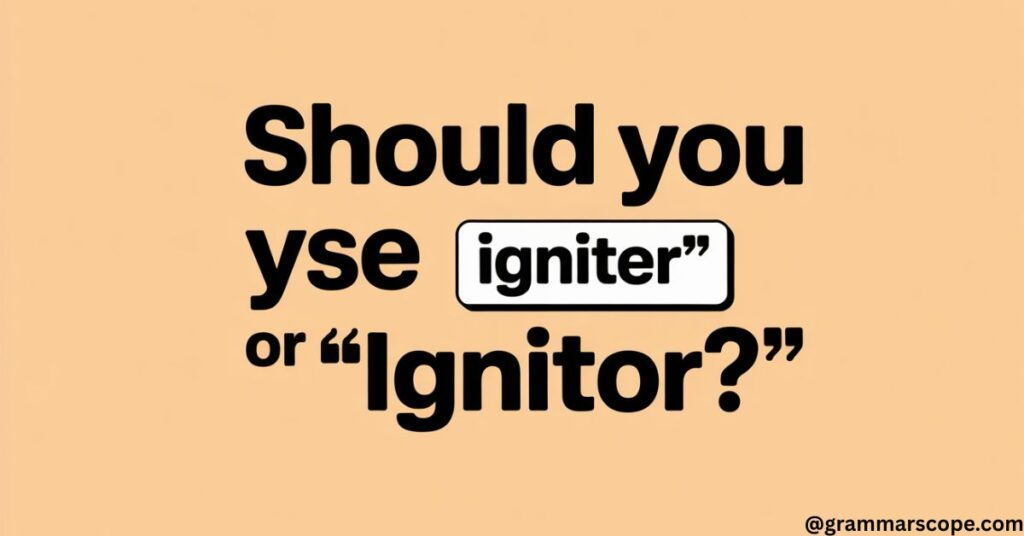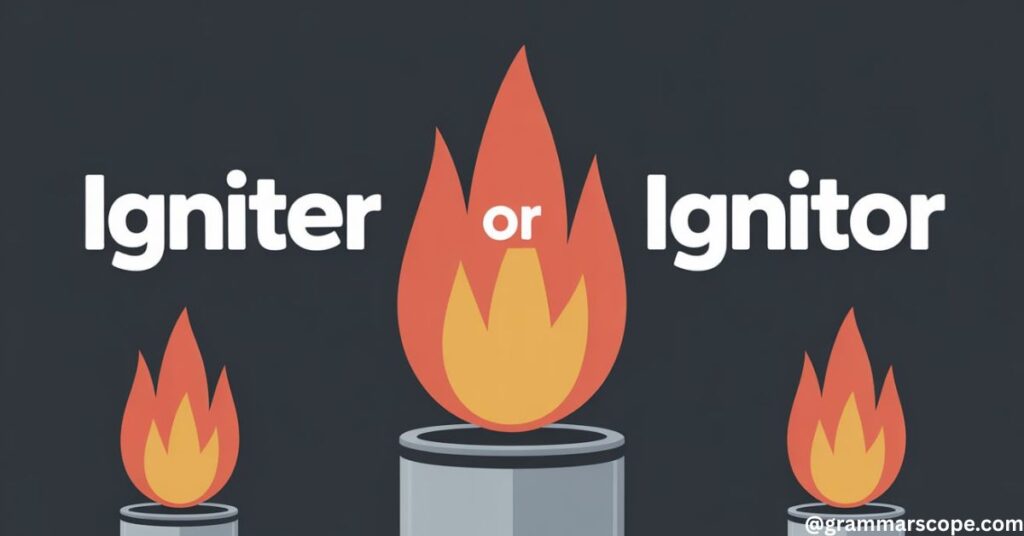Igniter or ignitor a small difference in letters, but a big question in clarity. When you’re writing technical manuals, sending parts to manufacturing, or even emailing customer support, spelling this term right can actually make a difference between clear communication and confusion. Especially in industries dealing with combustion devices, where precision matters, knowing which form to use could save time, money, and face.
Imagine this: you’re writing an installation guide for an electronic igniter, and your audience is split between American engineers and Australian field technicians. You keep wondering: “Is it ignitor or igniter? Which is correct, and do they both mean the same thing?” The truth is, both spellings exist but how, where, and why they are used is where the nuance lies.
In today’s globalized workplace, spelling isn’t just a matter of preference it’s part of your brand’s clarity and authority. Whether you’re working on technical documentation or sending an urgent email to a supplier, choosing the right spelling builds trust. So, if you’ve ever paused mid-sentence and thought, “How do you spell igniter?” you are not alone. Let’s clear up the smoke once and for all.
Why Is There Confusion?

The confusion between igniter and ignitor stems largely from linguistic evolution and regional preferences. While they refer to the same ignition device one that sparks combustion in engines, stoves, or even fireworks—the spelling varies depending on geography and industry tradition.
In American English usage, igniter is more widely accepted. Manuals, patents, and even manufacturers overwhelmingly use this form. On the other hand, ignitor appears occasionally in legacy product naming, especially in older or non-standard documents. This variation leads people to search online for answers to questions like, “Igniter vs ignitor which one is right?*”
In technical and professional settings, even small spelling differences can throw off consistency or create misunderstandings in global teams. That’s why understanding the subtle history and application of each version matters more than you might expect.
What Do “Igniter” and “Ignitor” Mean?
Both igniter and ignitor refer to a device that initiates combustion. Think of them as spark plugs for a process—whether you’re firing up a gas furnace or starting a jet engine. These devices ignite a fuel-air mixture either mechanically or electronically, depending on the system.
Here are a few common types:
- Flame igniter – Used in gas burners or grills
- Electronic igniter – Common in modern stoves and HVAC systems
- Spark plug – Used in internal combustion engines
Despite different uses, the root meaning stays the same: both terms describe tools used in the ignition system to initiate flame or heat. But again, igniter is the modern and more widely recognized spelling, especially in industries that require technical documentation or global communication.
Should You Use “Igniter” or “Ignitor”?

✅ Use “Igniter” When:
- Writing for a technical audience
- Creating manuals, parts lists, or instructions
- Communicating in American or international English
- Maintaining industry-standard language
🛑 Avoid “Ignitor” If:
- You’re unsure of regional preferences
- You’re writing official documents
- You’re submitting content for review or legal compliance
Here’s a scenario:
Email Example – Technical Support Request
Subject: Faulty Igniter Replacement for Model XZ-220
Hi Jason,We’ve identified that the electronic igniter in our Model XZ-220 has failed after repeated use. Could you please arrange a replacement under warranty?
Thanks,
Emily Clark, Field Technician
Now compare it to a more casual or outdated usage:
Legacy Documentation Excerpt:
“Ensure the ignitor is secured tightly before initiating the burner sequence.”
In today’s standards, the first example sounds more up-to-date and professional, aligning with best practices in technical documentation.
Synonyms of the Word “Igniter”
Need alternatives? Here are common synonyms you might use in various contexts:
- Firestarter – Often used in informal or survival contexts
- Spark device – General but clear
- Combustion initiator – Highly technical
- Ignition trigger – Descriptive and precise
- Pilot light – A specific type of ignition device
Each of these has its place, but none are perfect substitutes. When clarity matters especially with machinery or manufacturing igniter is your safest bet.
Examples in Context

Here are more real-world scenarios where spelling makes a difference.
💼 Business Email
Subject: Confirming Spec Sheet for Igniter Assembly
Hello Marco,Please review the attached documentation for the updated igniter assembly before our 3 PM call. Let me know if any adjustments are needed.
Best,
Angela
🔧 Product Manual (US English)
“Install the igniter with the wiring facing downwards. Do not apply power until all connections are confirmed.”
Blog Post Excerpt (British English/Australian variant)
“Whether you call it an ignitor or igniter, this small part is crucial for ensuring your heater functions reliably throughout winter.”
Origins of the Word “Igniter”
Both spellings originate from the verb ignite, meaning to catch fire or cause combustion. The “-er” ending is more typical in modern American English, following regular spelling conventions.
The “-or” ending, as in ignitor, is likely a holdover from older engineering texts or regional variants, particularly found in British or Australian English contexts.
Still, contemporary usage trends clearly favor igniter, especially in international industries where standardization is crucial.
Most Important Takeaway
If there’s one thing to remember, it’s this: Consistency is key. Whether you’re managing a legacy product naming system or writing fresh technical documentation, choose one spelling—preferably igniter—and use it consistently across all platforms.
When drafting documentation, set a style guide that includes terminology preferences. This avoids internal confusion and makes editing faster.
Always check your industry’s standards. For example, the U.S. Department of Energy and major appliance manufacturers use “igniter” exclusively.
Use search engines to analyze trends. A quick Google Ngram or keyword comparison will show that igniter is significantly more common in modern usage than ignitor.
Conclusion
So, igniter or ignitor—which spelling should you choose? The answer depends on clarity, audience, and context. But if you’re looking for the safest, most accepted option in today’s technical and professional world, go with igniter.
Whether you’re dealing with an ignition system, replacing a spark plug, or writing a how-to guide for a flame igniter, spelling matters more than you think. It signals precision, expertise, and professionalism.
So the next time you wonder how to spell igniter or whether ignitor vs igniter really matters—remember this article. And choose the form that sparks understanding, not confusion.

Emma Olivia is an experienced blogger and the creative mind behind Grammar Scope. With a passion for language and years of writing expertise, she crafts engaging, informative content that simplifies grammar and writing tips for readers worldwide. Emma’s dedication to clear communication and love for the written word shine through every article she publishes, making Grammar Scope a trusted resource for language enthusiasts and learners alike.







